QR Code Report: Detailed Analysis of Working, Popularity, and Uses
VerifiedAdded on 2021/04/21
|5
|1114
|152
Report
AI Summary
This report provides a comprehensive overview of QR codes, starting with their basic functionality. It explains the technical aspects, including the scanner, decoder, illuminator, and sensor components, and how these elements work together to read and interpret the codes. The report then explores the reasons behind the QR code's rapid increase in popularity, emphasizing the ease of creation and user-friendliness. The report also highlights the cost-effectiveness of QR codes and their widespread adoption across various platforms and devices. Furthermore, the report discusses the diverse applications of QR codes, including their use in retail, advertising, arts, and digital media. It concludes by emphasizing the significant potential of QR codes in media and business, while acknowledging the potential for future security threats and vulnerabilities.
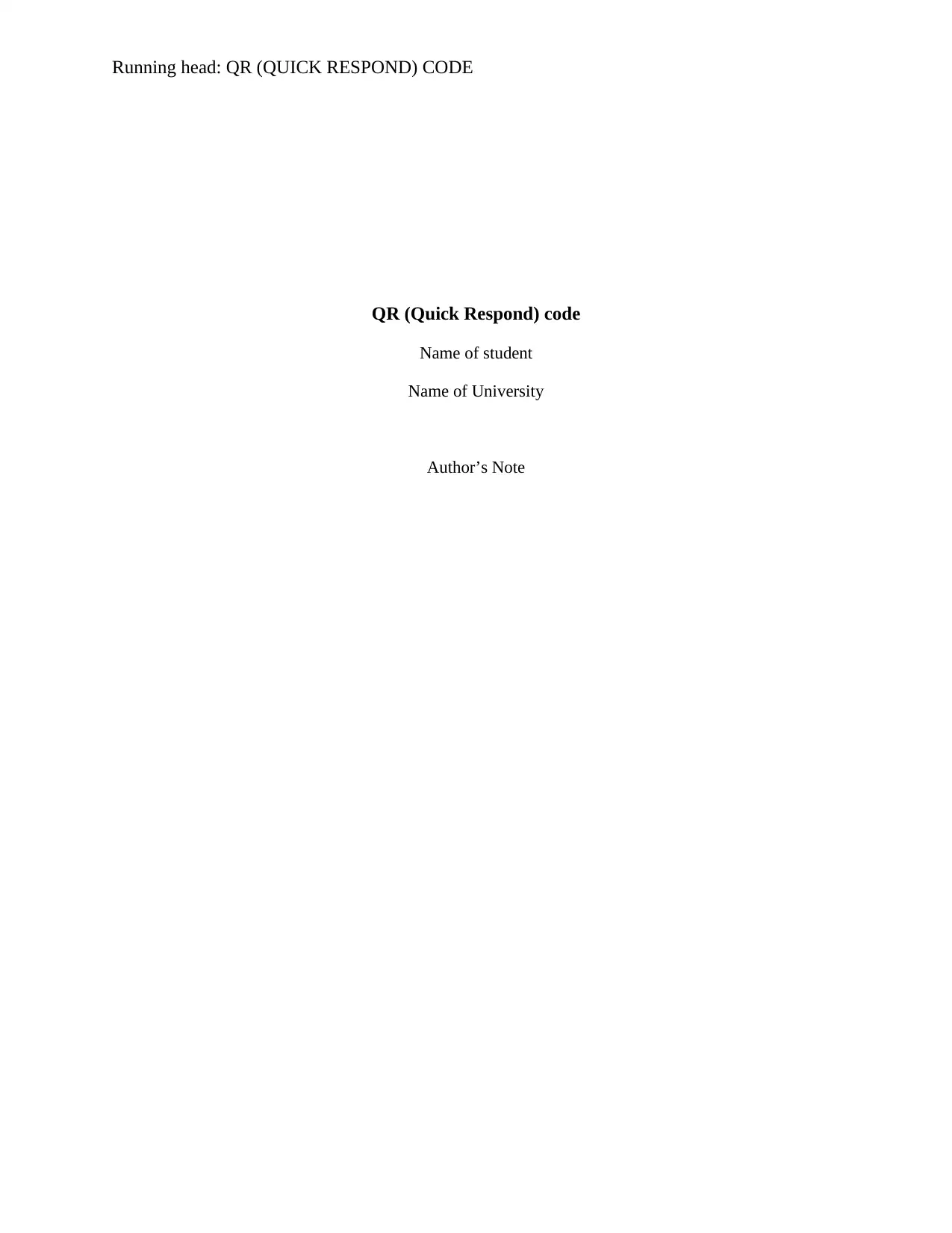
Running head: QR (QUICK RESPOND) CODE
QR (Quick Respond) code
Name of student
Name of University
Author’s Note
QR (Quick Respond) code
Name of student
Name of University
Author’s Note
Paraphrase This Document
Need a fresh take? Get an instant paraphrase of this document with our AI Paraphraser
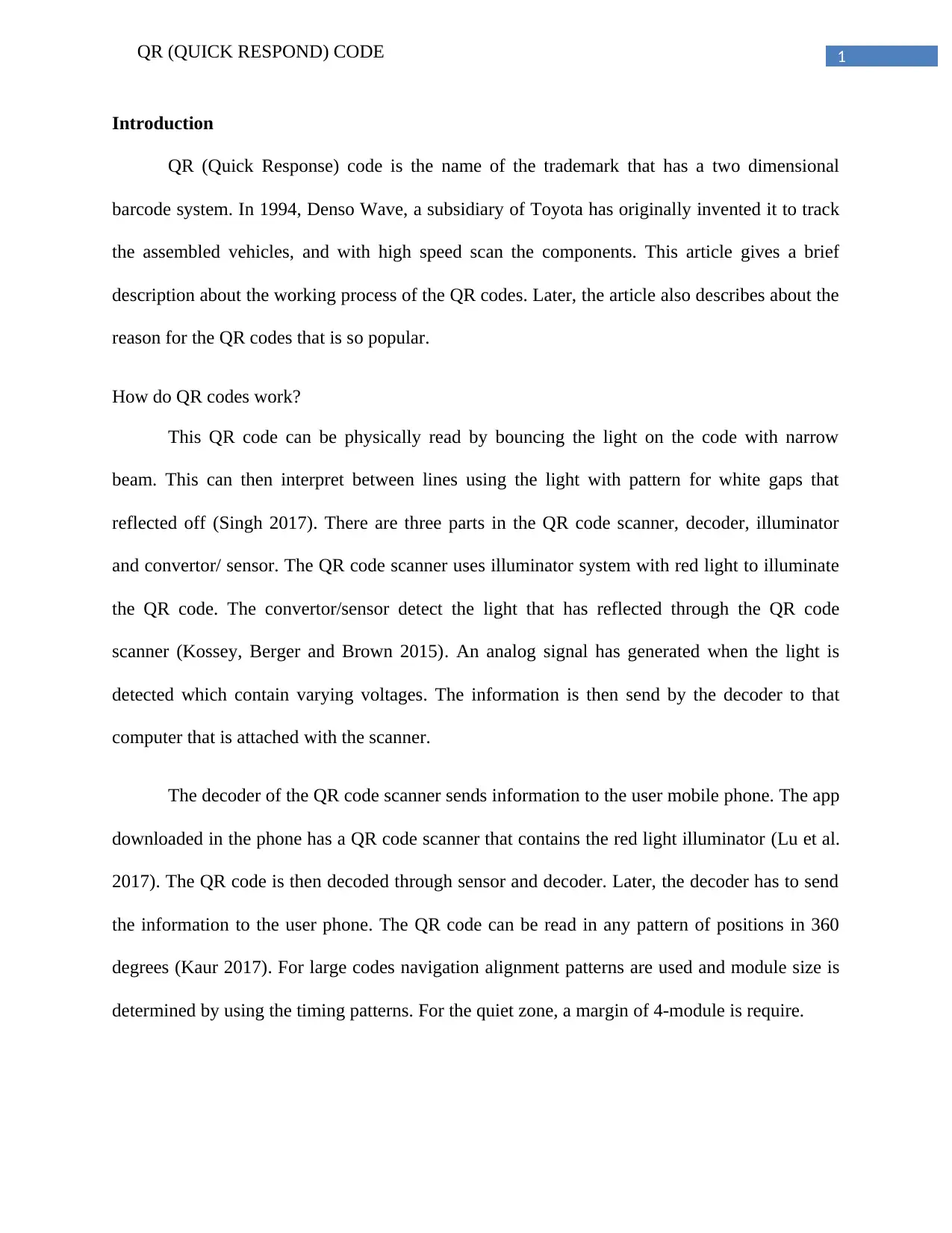
1QR (QUICK RESPOND) CODE
Introduction
QR (Quick Response) code is the name of the trademark that has a two dimensional
barcode system. In 1994, Denso Wave, a subsidiary of Toyota has originally invented it to track
the assembled vehicles, and with high speed scan the components. This article gives a brief
description about the working process of the QR codes. Later, the article also describes about the
reason for the QR codes that is so popular.
How do QR codes work?
This QR code can be physically read by bouncing the light on the code with narrow
beam. This can then interpret between lines using the light with pattern for white gaps that
reflected off (Singh 2017). There are three parts in the QR code scanner, decoder, illuminator
and convertor/ sensor. The QR code scanner uses illuminator system with red light to illuminate
the QR code. The convertor/sensor detect the light that has reflected through the QR code
scanner (Kossey, Berger and Brown 2015). An analog signal has generated when the light is
detected which contain varying voltages. The information is then send by the decoder to that
computer that is attached with the scanner.
The decoder of the QR code scanner sends information to the user mobile phone. The app
downloaded in the phone has a QR code scanner that contains the red light illuminator (Lu et al.
2017). The QR code is then decoded through sensor and decoder. Later, the decoder has to send
the information to the user phone. The QR code can be read in any pattern of positions in 360
degrees (Kaur 2017). For large codes navigation alignment patterns are used and module size is
determined by using the timing patterns. For the quiet zone, a margin of 4-module is require.
Introduction
QR (Quick Response) code is the name of the trademark that has a two dimensional
barcode system. In 1994, Denso Wave, a subsidiary of Toyota has originally invented it to track
the assembled vehicles, and with high speed scan the components. This article gives a brief
description about the working process of the QR codes. Later, the article also describes about the
reason for the QR codes that is so popular.
How do QR codes work?
This QR code can be physically read by bouncing the light on the code with narrow
beam. This can then interpret between lines using the light with pattern for white gaps that
reflected off (Singh 2017). There are three parts in the QR code scanner, decoder, illuminator
and convertor/ sensor. The QR code scanner uses illuminator system with red light to illuminate
the QR code. The convertor/sensor detect the light that has reflected through the QR code
scanner (Kossey, Berger and Brown 2015). An analog signal has generated when the light is
detected which contain varying voltages. The information is then send by the decoder to that
computer that is attached with the scanner.
The decoder of the QR code scanner sends information to the user mobile phone. The app
downloaded in the phone has a QR code scanner that contains the red light illuminator (Lu et al.
2017). The QR code is then decoded through sensor and decoder. Later, the decoder has to send
the information to the user phone. The QR code can be read in any pattern of positions in 360
degrees (Kaur 2017). For large codes navigation alignment patterns are used and module size is
determined by using the timing patterns. For the quiet zone, a margin of 4-module is require.
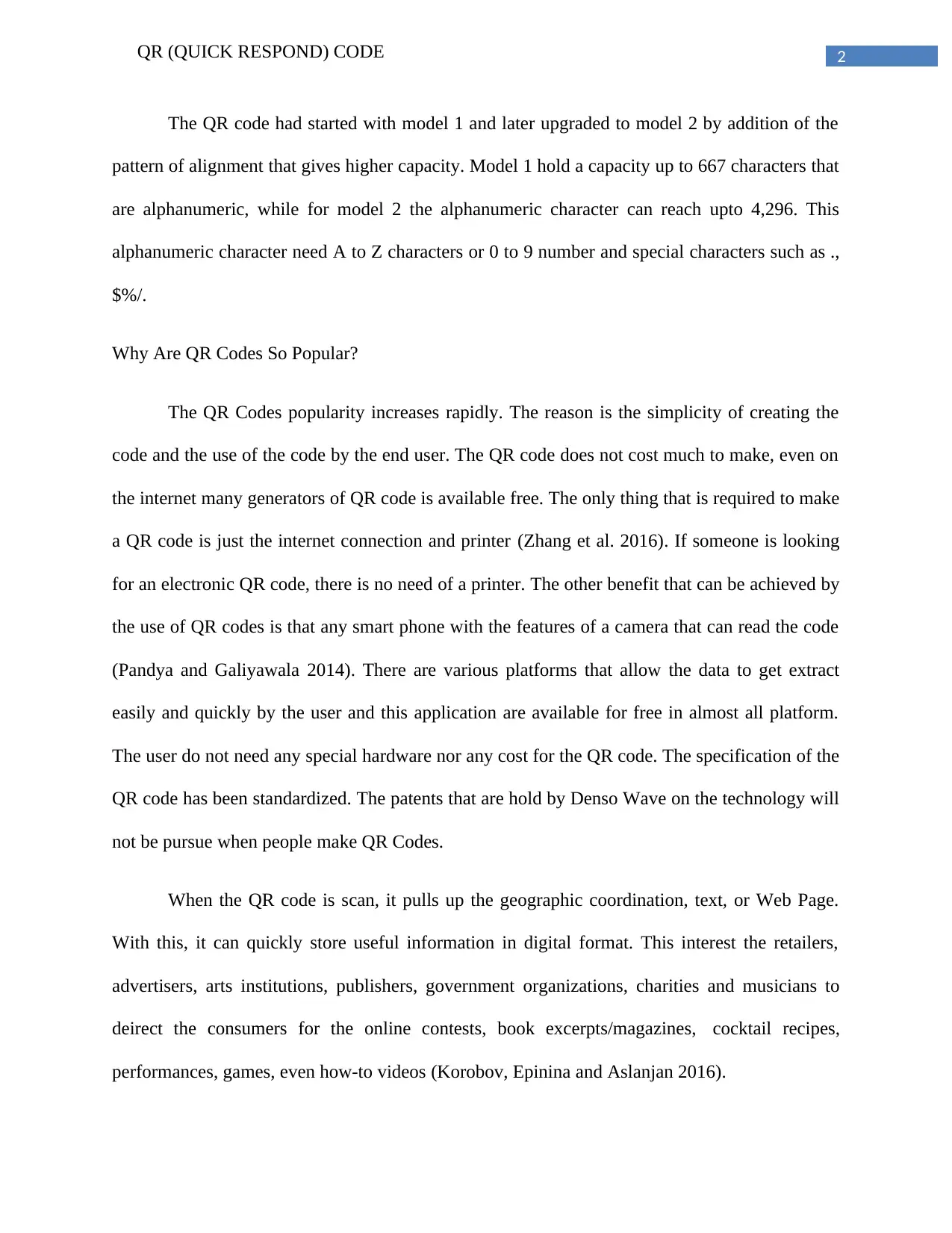
2QR (QUICK RESPOND) CODE
The QR code had started with model 1 and later upgraded to model 2 by addition of the
pattern of alignment that gives higher capacity. Model 1 hold a capacity up to 667 characters that
are alphanumeric, while for model 2 the alphanumeric character can reach upto 4,296. This
alphanumeric character need A to Z characters or 0 to 9 number and special characters such as .,
$%/.
Why Are QR Codes So Popular?
The QR Codes popularity increases rapidly. The reason is the simplicity of creating the
code and the use of the code by the end user. The QR code does not cost much to make, even on
the internet many generators of QR code is available free. The only thing that is required to make
a QR code is just the internet connection and printer (Zhang et al. 2016). If someone is looking
for an electronic QR code, there is no need of a printer. The other benefit that can be achieved by
the use of QR codes is that any smart phone with the features of a camera that can read the code
(Pandya and Galiyawala 2014). There are various platforms that allow the data to get extract
easily and quickly by the user and this application are available for free in almost all platform.
The user do not need any special hardware nor any cost for the QR code. The specification of the
QR code has been standardized. The patents that are hold by Denso Wave on the technology will
not be pursue when people make QR Codes.
When the QR code is scan, it pulls up the geographic coordination, text, or Web Page.
With this, it can quickly store useful information in digital format. This interest the retailers,
advertisers, arts institutions, publishers, government organizations, charities and musicians to
deirect the consumers for the online contests, book excerpts/magazines, cocktail recipes,
performances, games, even how-to videos (Korobov, Epinina and Aslanjan 2016).
The QR code had started with model 1 and later upgraded to model 2 by addition of the
pattern of alignment that gives higher capacity. Model 1 hold a capacity up to 667 characters that
are alphanumeric, while for model 2 the alphanumeric character can reach upto 4,296. This
alphanumeric character need A to Z characters or 0 to 9 number and special characters such as .,
$%/.
Why Are QR Codes So Popular?
The QR Codes popularity increases rapidly. The reason is the simplicity of creating the
code and the use of the code by the end user. The QR code does not cost much to make, even on
the internet many generators of QR code is available free. The only thing that is required to make
a QR code is just the internet connection and printer (Zhang et al. 2016). If someone is looking
for an electronic QR code, there is no need of a printer. The other benefit that can be achieved by
the use of QR codes is that any smart phone with the features of a camera that can read the code
(Pandya and Galiyawala 2014). There are various platforms that allow the data to get extract
easily and quickly by the user and this application are available for free in almost all platform.
The user do not need any special hardware nor any cost for the QR code. The specification of the
QR code has been standardized. The patents that are hold by Denso Wave on the technology will
not be pursue when people make QR Codes.
When the QR code is scan, it pulls up the geographic coordination, text, or Web Page.
With this, it can quickly store useful information in digital format. This interest the retailers,
advertisers, arts institutions, publishers, government organizations, charities and musicians to
deirect the consumers for the online contests, book excerpts/magazines, cocktail recipes,
performances, games, even how-to videos (Korobov, Epinina and Aslanjan 2016).
⊘ This is a preview!⊘
Do you want full access?
Subscribe today to unlock all pages.

Trusted by 1+ million students worldwide
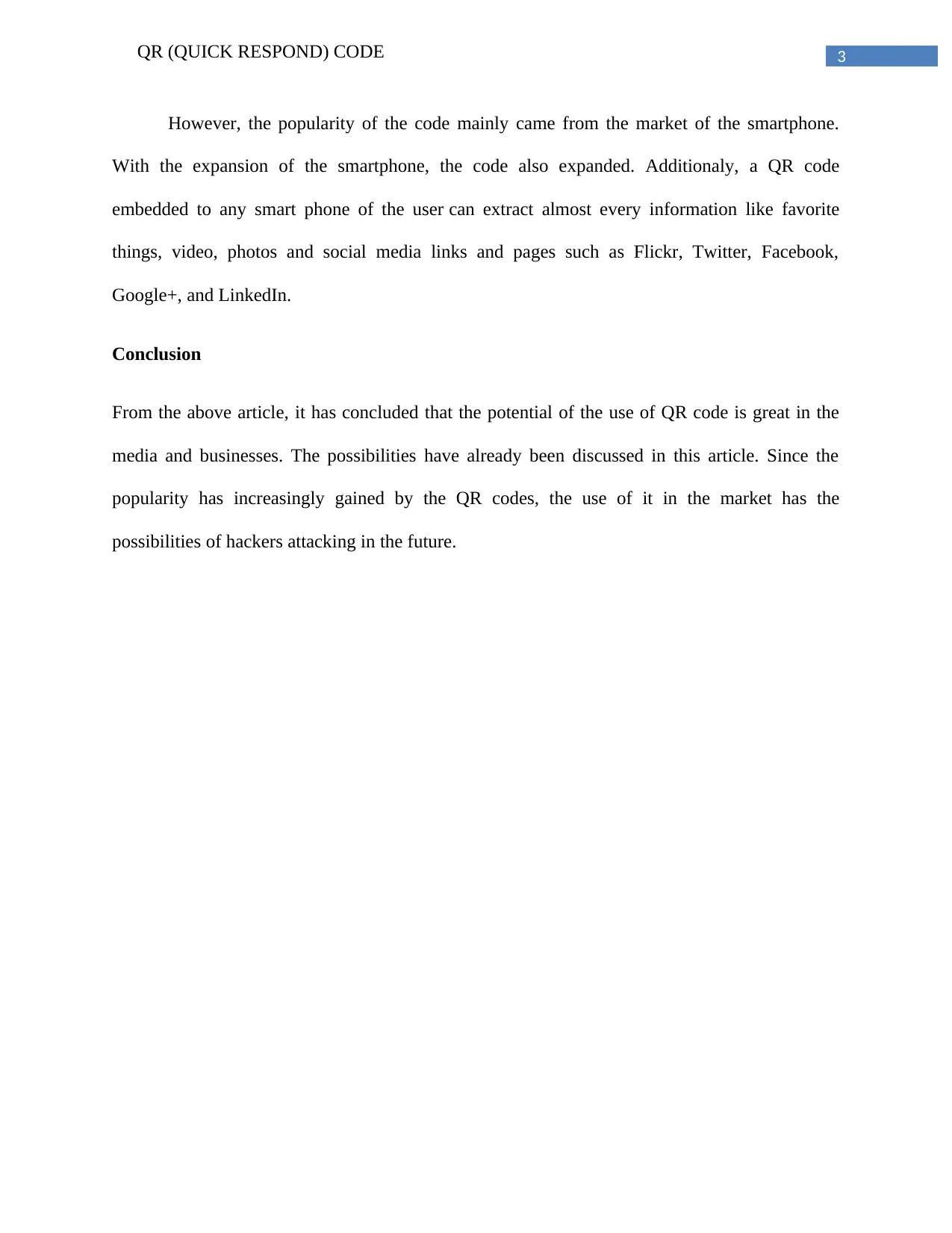
3QR (QUICK RESPOND) CODE
However, the popularity of the code mainly came from the market of the smartphone.
With the expansion of the smartphone, the code also expanded. Additionaly, a QR code
embedded to any smart phone of the user can extract almost every information like favorite
things, video, photos and social media links and pages such as Flickr, Twitter, Facebook,
Google+, and LinkedIn.
Conclusion
From the above article, it has concluded that the potential of the use of QR code is great in the
media and businesses. The possibilities have already been discussed in this article. Since the
popularity has increasingly gained by the QR codes, the use of it in the market has the
possibilities of hackers attacking in the future.
However, the popularity of the code mainly came from the market of the smartphone.
With the expansion of the smartphone, the code also expanded. Additionaly, a QR code
embedded to any smart phone of the user can extract almost every information like favorite
things, video, photos and social media links and pages such as Flickr, Twitter, Facebook,
Google+, and LinkedIn.
Conclusion
From the above article, it has concluded that the potential of the use of QR code is great in the
media and businesses. The possibilities have already been discussed in this article. Since the
popularity has increasingly gained by the QR codes, the use of it in the market has the
possibilities of hackers attacking in the future.
Paraphrase This Document
Need a fresh take? Get an instant paraphrase of this document with our AI Paraphraser
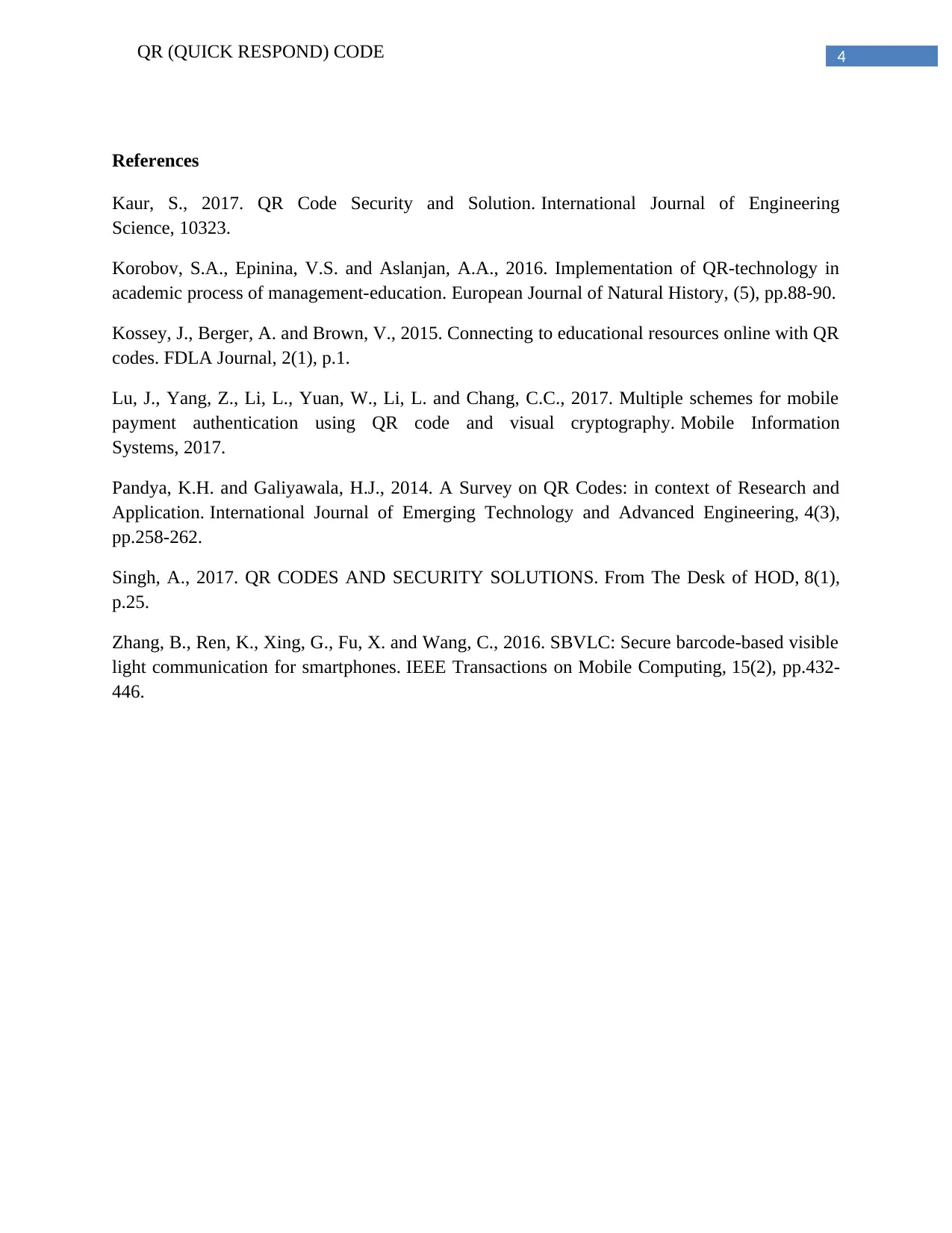
4QR (QUICK RESPOND) CODE
References
Kaur, S., 2017. QR Code Security and Solution. International Journal of Engineering
Science, 10323.
Korobov, S.A., Epinina, V.S. and Aslanjan, A.A., 2016. Implementation of QR-technology in
academic process of management-education. European Journal of Natural History, (5), pp.88-90.
Kossey, J., Berger, A. and Brown, V., 2015. Connecting to educational resources online with QR
codes. FDLA Journal, 2(1), p.1.
Lu, J., Yang, Z., Li, L., Yuan, W., Li, L. and Chang, C.C., 2017. Multiple schemes for mobile
payment authentication using QR code and visual cryptography. Mobile Information
Systems, 2017.
Pandya, K.H. and Galiyawala, H.J., 2014. A Survey on QR Codes: in context of Research and
Application. International Journal of Emerging Technology and Advanced Engineering, 4(3),
pp.258-262.
Singh, A., 2017. QR CODES AND SECURITY SOLUTIONS. From The Desk of HOD, 8(1),
p.25.
Zhang, B., Ren, K., Xing, G., Fu, X. and Wang, C., 2016. SBVLC: Secure barcode-based visible
light communication for smartphones. IEEE Transactions on Mobile Computing, 15(2), pp.432-
446.
References
Kaur, S., 2017. QR Code Security and Solution. International Journal of Engineering
Science, 10323.
Korobov, S.A., Epinina, V.S. and Aslanjan, A.A., 2016. Implementation of QR-technology in
academic process of management-education. European Journal of Natural History, (5), pp.88-90.
Kossey, J., Berger, A. and Brown, V., 2015. Connecting to educational resources online with QR
codes. FDLA Journal, 2(1), p.1.
Lu, J., Yang, Z., Li, L., Yuan, W., Li, L. and Chang, C.C., 2017. Multiple schemes for mobile
payment authentication using QR code and visual cryptography. Mobile Information
Systems, 2017.
Pandya, K.H. and Galiyawala, H.J., 2014. A Survey on QR Codes: in context of Research and
Application. International Journal of Emerging Technology and Advanced Engineering, 4(3),
pp.258-262.
Singh, A., 2017. QR CODES AND SECURITY SOLUTIONS. From The Desk of HOD, 8(1),
p.25.
Zhang, B., Ren, K., Xing, G., Fu, X. and Wang, C., 2016. SBVLC: Secure barcode-based visible
light communication for smartphones. IEEE Transactions on Mobile Computing, 15(2), pp.432-
446.
1 out of 5
Your All-in-One AI-Powered Toolkit for Academic Success.
+13062052269
info@desklib.com
Available 24*7 on WhatsApp / Email
![[object Object]](/_next/static/media/star-bottom.7253800d.svg)
Unlock your academic potential
Copyright © 2020–2025 A2Z Services. All Rights Reserved. Developed and managed by ZUCOL.